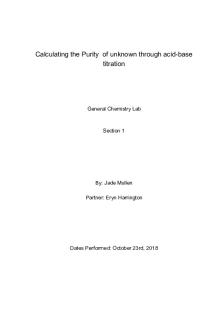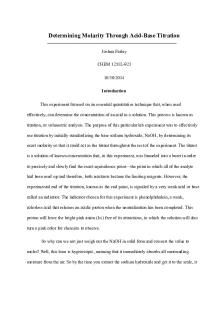Acid Base Titration Virtual Lab Nov 2020 PDF

| Title | Acid Base Titration Virtual Lab Nov 2020 |
|---|---|
| Author | mudasir elahi |
| Course | Chemistry |
| Institution | Quaid-i-Azam University |
| Pages | 7 |
| File Size | 188.3 KB |
| File Type | |
| Total Downloads | 72 |
| Total Views | 175 |
Summary
It tells us how acid-base titration can be done...
Description
Acid Base Titration 1. Define the following terms. Term analyte titrant equivalence point indicator end point
Definition
It is a substance whose concentration is to be determined during chemical reaction or procedure. It is a solution of known concentration in titration, also known as titrator. In titration, it is a point where the amount of added titrant solution is equal to titrand solution. A substance which shows a colour change due to its specific pH range and gives end point. During titration, it is a point where indicator changes its colour.
2. Log onto http://chemcollective.org/vlab/vlab.php and start the Virtual Lab Aplet. Click on Help and watch the Video Walkthrough. 3. You will be doing a series of 3 different titrations. Analyte Analyte Titrant Volume of Titrant Added Volume Each Time 0.10 M HCl 0.10 M HC2H3O2* 0.10 M NH3*
10.00 mL 10.00 mL 10.00 mL
0.10 M NaOH 0.10 M NaOH 0.10 HCl
0.50 mL 0.50 mL 0.50 mL
Total Volume of Titrant 15.00 mL 15.00 mL 15.00 mL
You will need a 50 mL burette for your titrant and a 250 mL beaker for your analyte. *You will be required to make 0.10 M concentrations of these analytes using the solutions in the cabinets, distilled water, a pipette, and a volumetric flask. Remember c1V1=c2V2 4. Create the table below for each titration. Your first entry should be a volume of 0 mL and your final volume 15 mL. Make sure you label each table, so you know which data goes with which titration.
Titration data for 0.10 M HCl and 0.10 M NaOH
Volume of Titrant Added (mL) 0
pH 1.0
0.5 1.0 1.5 2.0 2.5 3.0 3.5 4.0 4.5 5.0 5.5 6.0 6.5 7.0 7.5 8.0 8.5 9.0 9.5 10
1.04 1.09 1.13 1.18 1.22 1.27 1.32 1.37 1.42 1.48 1.54 1.60 1.67 1.75 1.85 1.95 2.09 2.28 2.59 7
10.5 11.0 11.5
11.38 11.67 11.84
12.0
11.95
12.5
12.04
13.0
12.11
13.5 14.0 14.5 15.0
12.17 12.22 12.26 12.30
Titration data for 0.10 M HC2H3O2 and 0.10 M NaOH Volume of Titrant Added (mL)
pH
0 0.5 1.0
2.88 3.51 3.81
1.5 2.0 2.5
4.01 4.16 4.28
3.0
4.39
3.5
4.49
4.0
4.58
4.5 5.0 5.5 6.0 6.5 7.0 7.5
4.67 4.76 4.84 4.93 5.03 5.13 5.23
8.0
5.36
8.5
5.51
9.0
5.71
9.5 10 10.5
6.04 8.72 11.38
11.0
11.67
11.5
11.84
12.0 12.5
11.95 12.04
13.0
12.11
13.5
12.17
14.0
12.22
14.5 12.26 15.0 12.3 Titration data for 0.10 M NH3 and 0.10 M HCl Volume of Titrant Added (mL) 0
pH 11.12
0.5
10.5
1.0
10.2
1.5 2.0 2.5 3.0 3.5 4.0 4.5 5.0 5.5 6.0
10 9.85 9.72 9.62 9.52 9.43 9.34 9.25 9.16 9.07
6.5
8.98
7.0
8.88
7.5
8.77
8.0 8.5 9.0 9.5 10.0 10.5 11.0 11.5 12.0 12.5 13.0 13.5 14.0 14.5 15.0
8.65 8.5 8.29 7.97 5.28 2.61 2.32 2.16 2.04 1.95 1.88 1.83 1.78 1.74 1.7
5. Create a separate titration curve (pH vs Volume Titrant added graph) for each titration.
Titration curve for 0.10 M HCl and 0.10 M NaOH
pH vs Volume of NaOH added 14 12 10
pH
8 6 4 2 0
0
2
4
6
8
10
12
14
16
14
16
Volume of NaOH added (mL)
Titration curve for 0.10 M HC2H3O2 and 0.10 M NaOH
pH vs Volume of NaOH added 14 12 10
pH
8 6 4 2 0
0
2
4
6
8
10
Volume of NaOH added (mL)
12
Titration curve for 0.10 M NH3 and 0.10 M HCl
pH vs Volume of NaOH added 12 10
pH
8 6 4 2 0
0
2
4
6
8
10
12
14
16
Volume of NaOH added (mL)
6. From your graphs, identify the equivalence point for each titration and indicate the pH at this point. Show this on the graph. Answer: pH at the equivalence point for 0.10 M NH3 and 0.10 M HCl is 7. pH at the equivalence point for 0.10 M HC2H3O2 and 0.10 M NaOH is 8.72. pH at the equivalence point for 0.10 M NH3 and 0.10 M HCl is 5.28. 7. Determine what indicator would be best for each of the titrations. Use the table provided. Answer: Phenolphthalein is best indicator for 0.10 M NH3 and 0.10 M HCl titration. Phenolphthalein is best indicator for 0.10 M HC2H3O2 and 0.10 M NaOH titration. Methyl orange is best indicator for 0.10 M NH3 and 0.10 M HCl titration. 8. For each titration, write a balanced chemical equation. HCl(aq) + NaOH(aq) NaCl(aq) + H2O(l) CH3COOH (aq) + NaOH(aq) CH3COONa(aq) + H2O(l) NH3(aq) + HCl(aq) NH4Cl(aq) 9. Identify what species are present at equivalence. Use this fact plus equilibrium equations to explain the pH that you observed at equivalence point. Answer: For 0.10 M NH3 and 0.10 M HCl titration, due to strong acid-base titration there will be complete neutralization and salt of strong conjugate acid base pair will be present. For 0.10 M HC2H3O2 and 0.10 M NaOH titration, due to weak acid -strong base titration there will be incomplete neutralization and conjugate base of weak acid will react with water. Thus, this will increase hydroxide concentration.
For 0.10 M NH3 and 0.10 M HCl titration, due to strong acid-weak base titration there will be incomplete neutralization and conjugate acid of weak base will react with water increasing proton concentration. 10. Confirm the accuracy of your results by theoretically calculating the pH at equivalence for each titration. Answer: The pH values at the equivalence point are as for 0.10 M NH3 and 0.10 M HCl is 7, for 0.10 M HC2H3O2 and 0.10 M NaOH is 8.72, for 0.10 M NH3 and 0.10 M HCl is 5.28. There are no theoretical values for pH that can be used to confirm the accuracy of my results....
Similar Free PDFs

Acid base titration lab report
- 5 Pages

Acid-Base Titration Lab Report
- 7 Pages

Acid-Base Titration Pre-Lab
- 4 Pages

Acid Base Titration
- 7 Pages

Acid Base Titration
- 15 Pages

Acid Base Titration
- 6 Pages

Afl Acid-Base Titration
- 6 Pages

Exp 08 Acid-Base Titration
- 10 Pages

Acid Base Titration 08 2019
- 11 Pages

Amino Acid Titration Lab
- 2 Pages
Popular Institutions
- Tinajero National High School - Annex
- Politeknik Caltex Riau
- Yokohama City University
- SGT University
- University of Al-Qadisiyah
- Divine Word College of Vigan
- Techniek College Rotterdam
- Universidade de Santiago
- Universiti Teknologi MARA Cawangan Johor Kampus Pasir Gudang
- Poltekkes Kemenkes Yogyakarta
- Baguio City National High School
- Colegio san marcos
- preparatoria uno
- Centro de Bachillerato Tecnológico Industrial y de Servicios No. 107
- Dalian Maritime University
- Quang Trung Secondary School
- Colegio Tecnológico en Informática
- Corporación Regional de Educación Superior
- Grupo CEDVA
- Dar Al Uloom University
- Centro de Estudios Preuniversitarios de la Universidad Nacional de Ingeniería
- 上智大学
- Aakash International School, Nuna Majara
- San Felipe Neri Catholic School
- Kang Chiao International School - New Taipei City
- Misamis Occidental National High School
- Institución Educativa Escuela Normal Juan Ladrilleros
- Kolehiyo ng Pantukan
- Batanes State College
- Instituto Continental
- Sekolah Menengah Kejuruan Kesehatan Kaltara (Tarakan)
- Colegio de La Inmaculada Concepcion - Cebu





